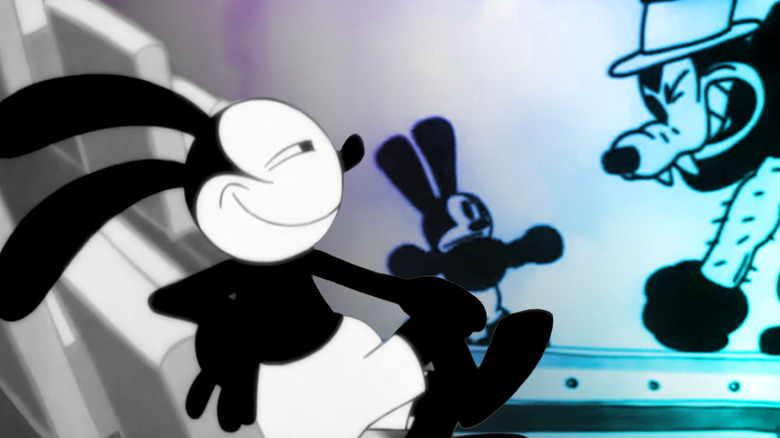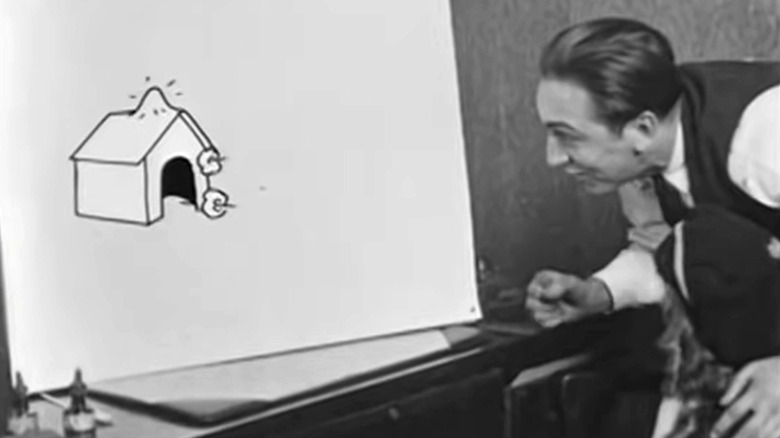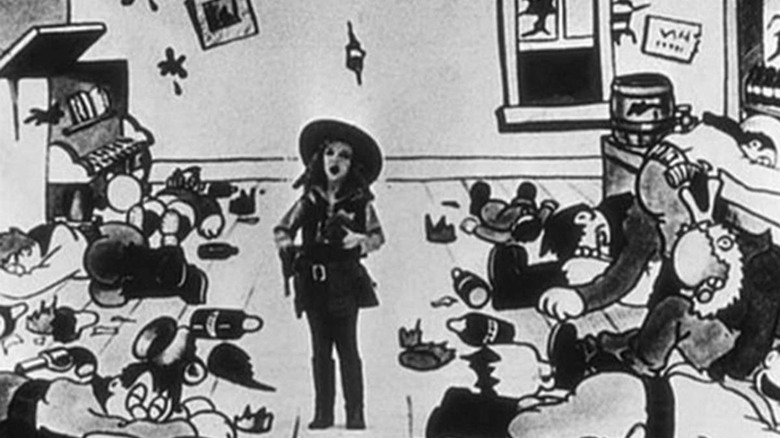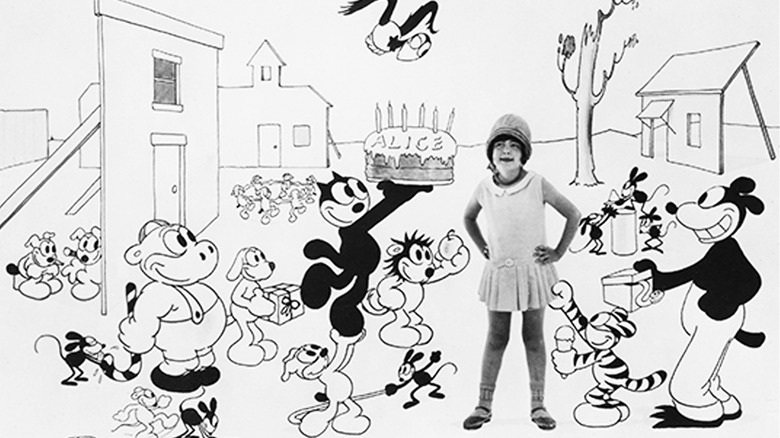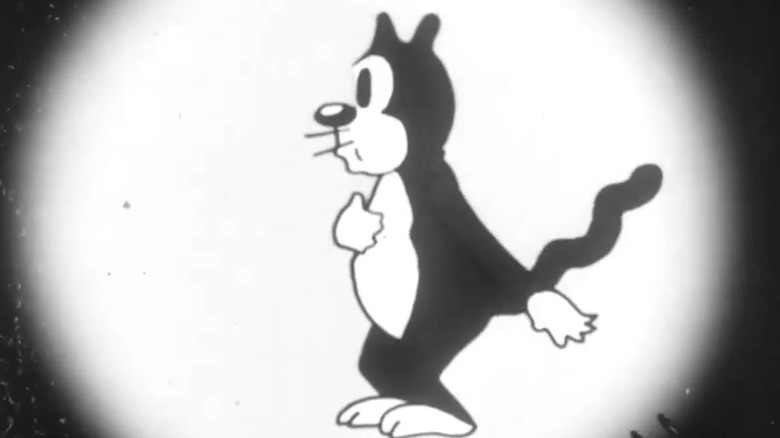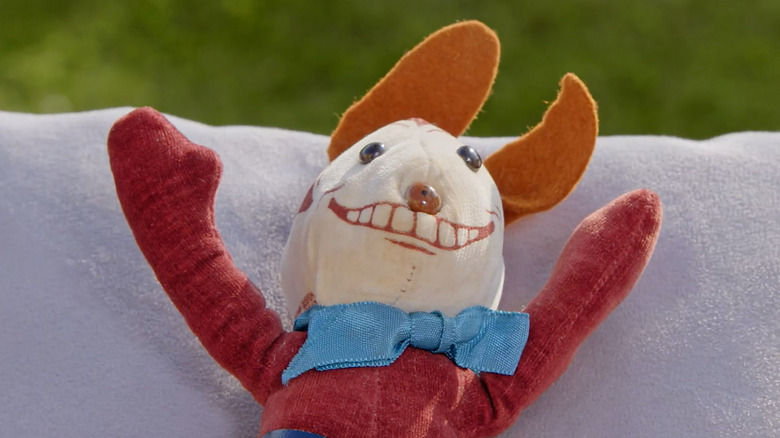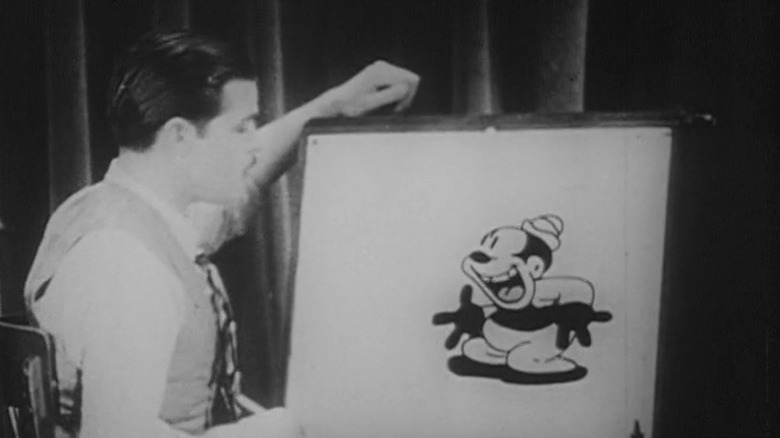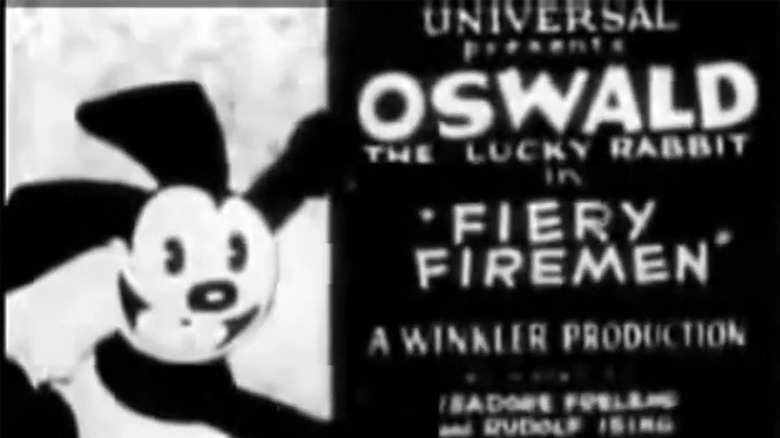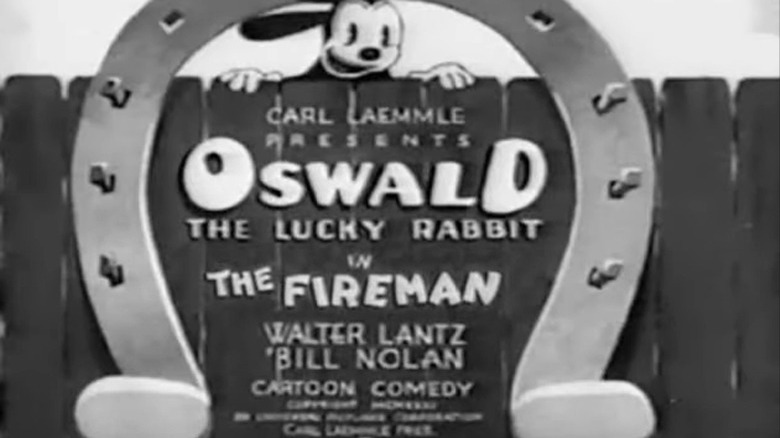Walt Disney Hits The Jackpot With Oswald The Lucky Rabbit
(Welcome to 100 Years of Disney Magic, a series examining the history, achievements, and legacy of The Walt Disney Company over the last century. Part 2, "The Dream Comes True: The Birth Of Disney Brothers Studio," investigated the animator arriving in Hollywood and founding the Disney Brothers Studio with his brother Roy. In Part 3, we explore the rise and fall of Walt's first breakout hit, Oswald the Lucky Rabbit.)
When we think "Walt Disney," one iconic cartoon character comes to mind: the shrill-voiced optimist, Mickey Mouse. Much like Kermit the Frog is to Jim Henson, the squeaky lil' anthropomorphized rodent is a reflection of his creator. Mickey Mouse is humble yet bold. He works hard. He loves his friends and family. He's distinctly American. Heck, Mickey was even voiced by Walt Disney initially. It's no wonder that mouse ears became a trademark icon for the Disney brand as a whole, appearing on T-shirts, rides, signs, toys, backpacks, stickers, and balloons. There have been countless ubiquitous merchandising opportunities (and don't get me started on the infamous Deadmau5 copyright drama).
But before Mickey whistled his way into the hearts of millions (possibly billions) there was another happy-go-lucky cartoon character that took the nation by storm. Walt Disney's first real taste of breakout success following his moderately received "Alice Comedies" was a plucky little bunny with long ears, wide eyes, and a big heart: Oswald the Lucky Rabbit.
Perhaps you've heard of him. Oswald celebrated turning 95 with a new Disney cartoon, which was released in December 2022. It was his first solo story in almost 90 years. But why the long absence? Well that, my friend, is a story of Hollywood hubris, bruised egos, shady dealings, behind-the-scenes drama, and the ultimate comeback kid, Walt Disney.
Walt Disney recruits Ub Iwerks (again)
Where we left off in Part 2, Walt and Roy Disney had just started to get the ball rolling with the "Alice Comedies." In early 1924, they moved into a new office space, with "Disney Bros." written in bold, gold lettering across the front window. The venture was initially a two-man operation with Walt doing all the creative work and his brother Roy O. Disney handling the business side (and, occasionally, operating a camera). Walt essentially animated the first six "Alice Comedies" himself. The experience taught him that he needed someone with better draftsmanship.
The "Alice Comedies" were fine, but Walt hadn't quite hit his stride with them. His distributor Margaret Winkler noted "customers ... found the Alice cartoons 'nice and clean' but felt they needed more laughs" (per Bob Thomas, "Walt Disney: An American Original"). Clearly, Walt needed help.
By June 1924, the company had grown to a point where the studio could afford an additional animator, assistants, and women to ink and paint the animation cels. They actually hired three of the latter since female laborers were cheap. (Thanks, 1920s sexism!) Walt had even coaxed Mickey Mouse's "father" Ub Iwerks to relocate to Hollywood. This was an enormous strike of luck for Walt, as Iwerks proved invaluable. After all, Iwerks helped create Disney's first big hits.
In his biography "Walt Disney: The Triumph of the American Imagination," Neal Gabler describes Iwerks as a "deft and rapid animator." Moving to Hollywood was a big risk — Iwerks was leaving a steady job to work for a man who had burned him a year prior — but it was exactly what Walt needed when he needed it.
So why did Iwerks uproot his life to join Disney Bros. halfway across the country? Thomas suggests Iwerks was drawn in by Walt's "rare powers of persuasion." Gabler suggests Iwerks just wanted to get away from his boss back in Kansas City. Regardless, his arrival marked a turning point for the up-and-coming animation studio.
Disney Bros. Studio struggles with the Alice Comedies
Ub Iwerks' decision to join Disney Bros. in the summer of 1924 was an extremely fateful decision. He had always been a talented artist, but over the five years that Walt Disney had known him, Iwerks' skills had grown significantly. Always looking to improve the quality of his product, Walt could rely on his team to turn out decent animation (sort of). It was still nowhere near the complexity of the Max Fleischer cartoons, but it was a start.
Animation was Walt's strength. In fact, that was because live-action filmmaking was, to put it gently, wanting. According to one animator, Walt's skill behind the camera was "about on par with the average box camera enthusiast" (via Gabler). Over time, the live-action Alice was supplanted by the cartoon sequences since it was easier for Walt to inject the comedy distributor Winkler Pictures kept requesting. This may have improved the overall quality of the product — something Walt cared deeply about — but it meant the pictures became increasingly expensive to produce.
Financial woes plagued Walt in those early years and were made worse by rising tensions with Winkler Pictures. Walt initially struck a deal with Margaret Winkler, who provided supportive, constructive feedback on his first few films. This would not last; Margaret married a man named Charles Mintz who took over operations shortly thereafter. (Gabler notes that Mintz took over when Margaret became pregnant. Bob Thomas states that she retired after marrying and that her new husband took over the business.) It's unclear if Mintz had any experience in the industry (some accounts say he did, others say he was a relative unknown), but he would prove a much less supportive business partner. He pressured Walt to put even more comedy in the pictures, complained about the quality of the live-action footage, and at one point, was sending half-payments when his own funds were tight (per Thomas).
Copy cat
By now, you've seen a few stills from the "Alice Comedies," and you might be thinking, "Gee, that cat sure looks familiar."
Julius the Cat, as he's known, bares a striking resemblance to another fictional feline: Felix the Cat from the Pat Sullivan series. This is no coincidence. Winkler Pictures also distributed Sullivan's cartoons, and, according to Neal Gabler, the similarity was intentional.
As for the Cat who performed these gags, the sudden appearance of a plump black feline with sharply pointed ears, goggle eyes, and a thick tail in "Alice's Spooky Adventure'"was probably instigated by Winkler, no doubt as a way of copying the more successful Felix series and perhaps, as some animation historians have speculated, even as a way of irritating Pat Sullivan, with whom she was constantly bickering.
To be fair, black cats did feature prominently in Walt's previous animation work, such as the cute widdle kitty-witty in 1922's "Puss in Boots" Laugh-O-gram. The first "Alice Comedy" to be sold to theaters, 1924's "Alice's Spooky Adventure," featured a version of Julius who looked very different from Felix, apart from the basic coloring in the face and the prominent bulbous nose (see below).
As the "Alice Comedies" went on, Julius looked more and more like Felix. The cat's body was changed to all black — arguably, it was easier to animate cleanly — while his proportions shifted over time. He became shorter, his belly rounder, and his paws much more spherical. You just have to look at a still of Felix the Cat from the same time period to see the resemblance to Julius.
Under the thumb
The Julius vs Felix debate doesn't really have any significance in the history of The Walt Disney Company. The characters that made Walt Disney famous came later and were distinct (different animals, and they wore pants!) but it's an interesting aside to think about in relation to the company's early period. Walt learned a lot from his experience with Winkler Pictures. He learned how to animate gags for maximum comedic effect. He learned how to fail and survive in Hollywood. Most importantly, he learned that he didn't want to be under the thumb of someone paying the bills, and dictating creative choices.
It's hard to know what exactly was going through Walt's mind in the mid-1920s, but it seems unlikely that he enjoyed Charles Mintz telling him how his characters should look or that he needed to do more to copy what was already popular. Walt was never one to rest on safe bets and settle for medoicrity. He was a visionary. Looking at these old "Alice Comedies," it seems the experience taught Walt that he needed to be forward-thinking in order to thrive — a lesson that would prove true over and over again, from "Steamboat Willie" to "Snow White" to even the creation of Disneyland.
Oswald enters the picture
Just as the "Alice Comedies" were winding down in 1926, a new opportunity appeared — one that was far too enticing to turn down. The "Alice Comedies" were made for Winkler Pictures, but they weren't attached to a big studio. I could do a whole article explaining block booking in the 1920s and the system of studio-owned theaters (or at least someone much smarter than I could) but suffice it to say, having a deal with a studio meant more opportunities. So when Charles Mintz managed to work out a deal with Universal Pictures, which was looking to reenter the cartoon market, it was quite the get for Winkler Pictures.
This series was Walt Disney's chance to break out, and he knew it. After Universal approved hi preliminary concept and sketches of Oswald the Lucky Rabbit, Walt shifted all his focus to the first Oswald short. The initial film "Poor Papa" was rejected by the Universal reviewing committee. They sent back notes; some of which Walt disagreed with, some of which he learned from. Ultimately, this experience would help shape the winning formula for early Disney. As Bob Thomas notes in his biography, Walt learned that a "strong attractive central character was essential ... He also learned that film-company committees could throttle creativity." (Something today's studios could benefit from remembering.)
Walt and Ub Iwerks worked hard on the character's design, pulling late nights fine-tuning Oswald to maximize likability and appeal (per Thomas). Having learned from his mistakes with the "Alice Comedies," Walt ensured the character was as fleshed out as possible — rather than simply a vehicle for random, strung-together gags as Julius had become. What Disney wanted to do was something novel for cartoons at the time: He wanted to write situations where comedy could develop organically from the characters.
A star is born
Walt and Ub's hard work paid off. The first Oswald comedy, "Trolley Troubles," was well-received. Despite being turned around in a shocking two-week time period, "Trolley Troubles" was met with enthusiasm from the trade press. Neal Gabler suggests this was "less a reflection of Walt [Disney]'s creativity than of the rather low state of animation in the mid-1920s." But still, it was the best reception Disney Bros. (now renamed Walt Disney Studio) had received to date. Gabler also notes that many animation historians praise Oswald and that some even considered the quality to be industry-standard at the time.
The trade publications certainly gushed about the series. Moving Picture World wrote "these Disney creations are bright, speedy and genuinely amusing" (via Bob Thomas), and Motion Picture News predicted, "This series is destined to win much popular favor" (via Gabler). In the essay "From Alice to Mickey" (via "The Walt Disney Film Archives. The Animated Movies 1921–1968"), Russell Merritt notes that Oswald "quickly became Disney's first major star" and that "Oswald [exploded] with energy and wild comic invention" unlike anything in the "Alice Comedies."
Almost a hundred years on, one can see the marked difference between "Trolley Troubles" and even a later "Alice Comedy" like "Wooley West." Julius' movements are rigid and jerky, whereas Oswald's are more natural and loose. The latter is immediately more visually appealing, which makes the gags funnier and the animation itself more compelling. I'd argue that the Oswald cartoons hold up much better than anything Disney created prior to that.
Before Mickey ears, there were Oswald buttons
Over that first year, Oswald just got better and better. Walt Disney was using what he had learned from being in Los Angeles and working in live-action filmmaking and applied it to his cartoons in new and exciting ways. As Russell Merritt writes,
Now more than ever, [Walt] was taking his cue from Hollywood to give his films a kinetic sense of time and space. He simulates complex camera tracking movements, starts using high and low camera angles, and breaks up scenes into larger numbers of shots.
Universal Pictures had a hit on its hands. Doing as studios often do with popular cartoons, they started merchandising the character. Oswald's face appeared on candy, buttons, and even stencil sets (per Bob Thomas). Heck, a sad-looking Oswald dolly made a surprise appearance on "Antique's Roadshow" just this past year. Walt, of course, did not see a red cent of royalties. He didn't technically own the character and — at the time — was just happy for the additional publicity. He would learn better.
For really the first time in his career, Walt was getting noticed in a serious way. Sure, Oswald did well with audiences, but more than ever, Walt Disney Studio was drawing (pardon the pun) the attention of the New York cartoon scene. It was a good thing too because trouble was brewing in paradise. On the surface, this was a major win for the studio, but behind the scenes, the entire system was headed for collapse.
Troubles stir at Walt Disney Studios
Walt Disney left Kansas City in 1923, hoping to find a brighter future in the sunny hills of Los Angeles. The city had no animation scene, so when Walt and Roy had the opportunity to build a studio, there were limited options for hired help. The best animators were across the country in New York City. Even if Walt could convince some of them to abandon their positions, he didn't really have the money to pay them close to what they were already making.
So, Walt reached out to the animators he knew from Kansas City: Rudy Ising (above), who was just a high school student when he started apprenticing for Laugh-O-gram; Hugh Harmon, the co-founder of the short-lived Kay Cee Studios who worked alongside Walt at Kansas City Film Ad Company; Isadore "Fritz" Freleng, another Film Ad Co. veteran; and, of course, Ub Iwerks. Back in Missouri, Walt had fostered a fun, collaborative work environment (at least until the money ran out). This was what the young animators found when they arrived in Hollywood, but unfortunately, it did not last.
Over the two years that they produced the "Alice Comedies" in Los Angeles, the work culture changed. Walt went from supportive and friendly to tense and, according to some accounts, abusive. He was under a lot of pressure from Charles Mintz to deliver high-quality work under budget — payment and costs always seemed a contentious issue. Unfortunately, Walt's response was to channel that pressure onto his team, often coming across as demanding, harsh, and impatient. As Neal Gabler writes in his biography:
Tired of the harangues and insults, [Harmon] and Ising had conspired to lure other animators, including Iwerks, to abandon Walt and join them in starting their own rival studio ... Before he left, Ising described the studio as a 'den of strife and vexation.' ... But the resentments would linger; they would linger long, and they would linger hard. They would linger until they wrecked the studio.
Disney learns another harsh lesson
Charles Mintz did not have faith in Walt Disney's ability to run his own studio. It wasn't long into their business relationship when Mintz started sending his brother-in-law George Winkler to check in on operations. This continued after the "Alice Comedies" ended and the Oswald shorts began. Little did Walt realize that Winkler was also talking to his animators behind his back, converting those already frustrated by Walt to align themselves with Mintz instead.
By February 1928, Universal Pictures' original order of 12 Oswald cartoons was almost up. Mintz was expected to sign a new three-year deal based on the series' success, which meant he also needed a new contract with Walt Disney Studio. Unbeknownst to Walt, however, he was not part of Mintz's view of the future. In fact, Walt was completely blindsided when Mintz gave him an insulting offer: Instead of increasing the budget per film, Mintz offered just the negative costs ($1,400) and 50% of profits, with "salaries" for staff — a move designed to undermine Walt's authority. Basically, Mintz was asserting that Winkler Pictures made the cartoons and Walt Disney Studio was nothing more than a subcontractor.
Naturally, Walt was rebuffed. He asked for time to think over the terms and went about trying to lock down his affairs, only to discover he had been outmaneuvered. Many of the animators were planning to side with Mintz — something Ub Iwerks had actually warned Walt about previously, but Walt didn't believe him — and Winkler Pictures was poised to completely take over operations.
Walt Disney loses again
After a year of newfound success with the Oswald cartoons, Walt Disney was devastated. Per Neal Gabler, "Walt had suffered two heavy blows. He had become expendable at his own company, and his own employees had betrayed him."
Although there was some further back and forth, there wasn't much for Walt to do. Charles Mintz's final offer was more blunt: He would pay $1,800 per picture and 50% of profits, but he would assume full operational control, with Walt and Roy drawing a salary as his employees. Walt chose to walk away with nothing, starting again for the third time in a few short years, rather than enmesh himself further with someone like Mintz.
This proved to be a good thing. After taking over the Oswald series, Mintz founded his own animation studio at Winkler, using the animators he had poached from Disney. Before long, they did to their new boss what they had done to Walt. Rudy Ising and Hugh Harmon went behind Mintz's back and asked Universal Pictures owner Carl Laemmle to get rid of Mintz and put them in charge. Universal, no doubt annoyed with all this drama, would get rid of Mintz — but then moved production to its own studio under the supervision of Walter Lantz, leaving Ising and Harmon high and dry. Whoops
Disney walked away from Oswald with a fire burning in his belly. He had enjoyed a taste of fame but he wanted more. Crucially, he wanted an icon that would be undeniably his — he wanted all creative rights.
He'd done a cat and he'd done a rabbit. With the old adage of the third time's a charm, Walt went back to the drawing board to create a new cartoon hero: a mouse.
Join us next week for 100 Years of Disney Magic Part 4: "Mickey Mouse Makes History In Steamboat Willie."
